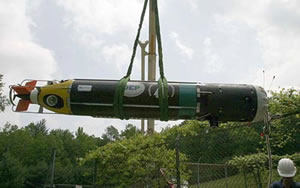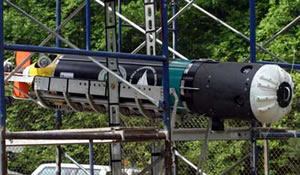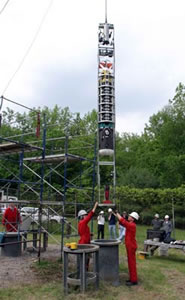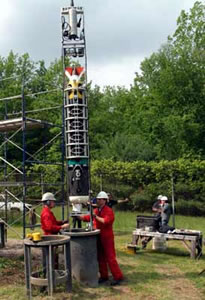FOR IMMEDIATE RELEASE03-31 June 6, 2003 Contact: Ian Michaels (718) 595-6600 Unmanned Submersible Vehicle Completes Inspection Voyage Of City’s Delaware Aqueduct - “ULIISYS” Is Home16-Hour Trip Through 45 Miles Of Tunnel Maps Aqueduct For Future Repair Plans
Commissioner Christopher O. Ward of the New York City Department of Environmental Protection (DEP) announced today that an unmanned underwater vehicle has completed a trip through the 45-mile Rondout-West Branch Tunnel of the Delaware Aqueduct, one of the City’s main connections to its upstate water supply. The inspection is Phase II of a project to map leaks in the Aqueduct in order to develop a long-term repair plan. “The data collected by the submersible vehicle will be analyzed closely by DEP engineers to determine the precise nature and location of the leaks we know to exist in the Delaware Aqueduct,” said Commissioner Ward. “I would like to thank the Woods Hole Oceanographic Institution and everyone who worked on this unique project for making it a success.”
The self-propelled Autonomous Underwater Vehicle (AUV) -- dubbed ULIISYS for Underwater Linear Infrastructure Investigation System -- was inserted into the Aqueduct at 5:00 P.M. on Thursday, June 4, near the Rondout Reservoir in Ulster County and was removed 16 hours later near the West Branch Reservoir in Putnam County. Along the way, the vehicle took over 160,000 digital images of the Aqueduct and recorded conditions using pressure sensors, velocity sensors and hydrophones.
The Delaware Aqueduct was constructed between 1939 and 1945, and typically conveys around half of the City’s daily water supply from the Delaware Water System in the Catskill Mountains. The Aqueduct is a 13.5 ft. diameter, concrete-lined tunnel that varies from 600 to 2,400 feet below ground. The DEP is aware of at least two leaks in the Aqueduct at two fault zones near Wawarsing and Roseton. The leaks combine to release between 10 million gallons of water a day and 36 million gallons a day, depending on the amount of water the Aqueduct is carrying. Monitoring has shown that the leaks have not grown in size in the last five years, and independent engineering analyses have confirmed that the Aqueduct is not in danger of collapse. If not fixed, though, over many years the leaks could develop into threats to the Aqueduct.
Other inspection methods used by the DEP include aerial flyovers of the Aqueduct with infrared cameras, test borings to sample soil conditions, acoustic testing and inspections of four tunnel shafts near the leaks. The AUV is self-steering and has no tether attached to it. It is based on the REMUS vehicle, which the Woods Hole Oceanographic Institution has developed and extensively tested for the US Navy. A similar test vehicle traveled the same route in January 2002 in preparation for this week’s inspection. Digital photos are available. Please call for more information.
| ||||||||||



